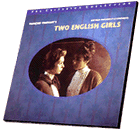

France film school
1971
color 130 min.
Director: Francois Truffaut
CLV: $69.95 - available
2 discs, catalog # CC1377L
VHS: available from Home Vision Cinema
The importance of Two English Girls lies in its sheer
vitality. The film is an extraordinary cinematic conjuring trick in
which Truffaut draws the viewer both physically and visually into his
own personal pleasures. He does this on a multitude of levels -- if
the pastoral scenes salute the work of Jean Renoir, then the washed
pastel colors of Nestor Almendros' Impressionist-influenced
cinematography perfectly evoke Truffaut's delight in the paintings of
Renoir's father, Auguste. But the pleasure that Truffaut most
literally saved for himself, by choosing to use his own voice for the
narration, was the prose of Henri-Pierre Roché, the novelist
whose work served as the source for Two English Girls As
Truffaut once observed, "If the beauty of a literary work lies in its
prose, there is no reason not to let this prose be heard in the
cinema."
A decade earlier, Roché's novel Jules and Jim
had been the source for one of Truffaut's signature films, but it was
not until 1971 that the filmmaker felt capable of bringing Two
English Girls to the screen. Both films are set in the early part
of the 20th century, and both focus upon mismatched romantic trios and
central figures who deal with life through art, rather than living it
directly. But Jules and Jim is a youthful effort, less an
expression of Truffaut's deepest sensibilities than those of a
filmmaker still learning how far his work of the moment can take
him. Two English Girls is a more complex and mature film, a
virtuoso work by the 40-year-old Truffaut, deeply passionate but
suffused with a regret that the younger Truffaut could not fully
explore.
Claude Roc (played by Jean-Pierre Léaud) is a writer
so painfully detached and passive that upon publication of his first
novel, Jerome and Julien (a clear homage to Roché's
Jules and Jim he says that the book's characters suffered for
him. This detachment reflects Truffaut's own feelings of alienation,
expressed throughout his career, and which dated back to his youth as
a borderline delinquent. His childhood rebellions culminated in his
desertion from the French army and his subsequent imprisonment. It was
through the intervention of Andr@eacute Bazin that Truffaut -- a lover
of movies and literature from childhood -- began writing about film,
eventually publishing the article that established the "auteur theory"
of filmmaking in Bazin's seminal film journal Cahiers du
Cinema.
The autobiographical component of Truffaut's work is
obvious in films like The 400 Blows, which was his debut, and
his subsequent Day for Night, but by 1971 this personal aspect
of his art had achieved a daunting complexity, emphasized in Two
English Girls by his casting of Jean-Pierre L@eacuteaud as the
protagonist Claude. Léaud had become Truffaut's cinematic
alterego, portraying Antoine Doinel, Truffaut's on-screen "stand-in"
in The 400 Blows, and later in Love at Twenty, Stolen
Kisses, and Bed and Board.
Claude lives through his book,
and his life becomes art, or actually, literature. This is similar to
Balzac, the other literary figure pictured in the film, who
constituted a personal literary touchstone from Truffaut's childhood
and is seen in the guise of Rodin's statue at the film's beginning and
end. Claude's passion recalls the way in which people "become" books
in Truffaut's Fahrenheit 451 -- on different levels, both
Claude and the "book people" in the earlier film literally give their
lives to art. Indeed, Fahrenheit 451 seems to point the way
toward Two English Girls, not only thematically but
visually. Two English Girls' opening credits, for example, are
built on multi-angle close-up shots of copies of Roché's novel,
and deliberately recall Truffaut's striking close-ups on books in
Fahrenheit 451.
In adapting the film, Truffaut devoted
himself not only to the book, but to the thought processes and
biographical detail behind it. The screenplay, written by Truffaut and
Jean Gruault, was based not only on the novel but also on
Roché's unpublished private diaries, to which Truffaut had
access, making the textual influences and the inter-penetration of
diary, novel, and film all the more fascinating and complex. The film
resounds with themes and elements that interested and obsessed
Truffaut throughout his career, but many of these themes flow directly
from Roché: the incalculable complexity of love between men and
women, the detached protagonist and the mismatched romantic partners,
locked in love and crippled by its consequences. But Two English
Girls sets itself apart by its sheer grace and palpable beauty,
and if the film is a monument to Truffaut's most prized and personal
pleasures, our greatest pleasure is simply in observing the conjurer
at work.
-- Bruce Eder
CREDITS
Directed by:
Francois Truffaut
Produced by: Marcel Berbaut
Production
Manager: Claude Miller
Screenplay by: Francois Truffaut and Jean
Gruault
Based on a novel by: Henri-Pierre
Roché
Photography by: Nestor Almendros
Edited by: Yann
Dedet
Art Direction by: Michel de Broin
Costumes by: Gitt
Magrini
Music by: Georges Delerue
David
Markham
TRANSFER
This edition of Two English Girls is proudly presented in its
original European theatrical aspect ratio of 1.75:1. This new digital
transfer was created from the 35mm intermediate positive and 35mm
magnetic master soundtrack.




